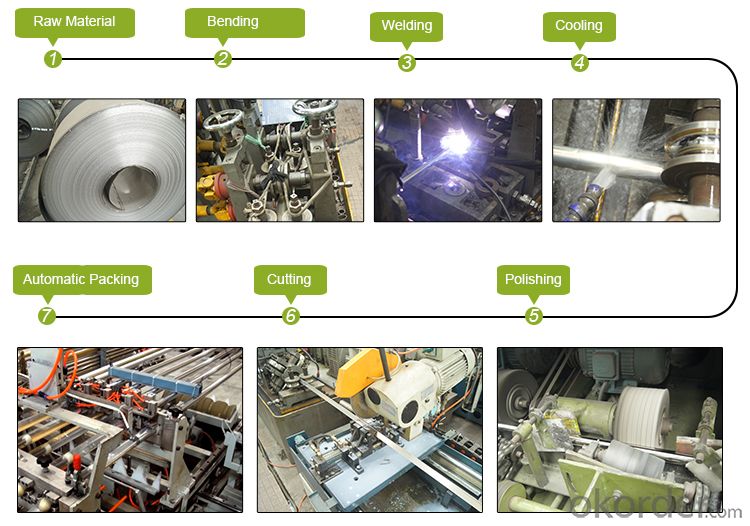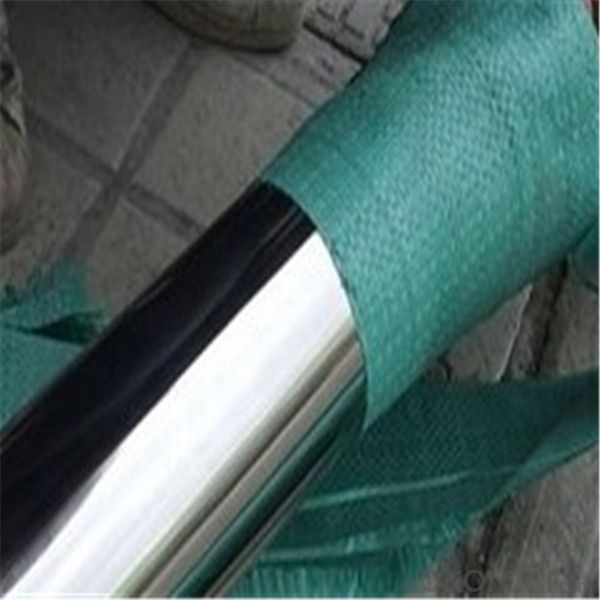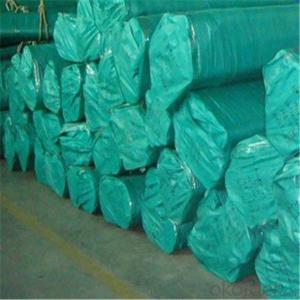304 321 316 316l Stainless Steel Seamless Pipe in Wuxi ,China
- Loading Port:
- Shanghai
- Payment Terms:
- TT OR LC
- Min Order Qty:
- 3 m.t.
- Supply Capability:
- 25000 m.t./month
OKorder Service Pledge
OKorder Financial Service
You Might Also Like
Item specifice
Product Description
C | Si | Mn | P | S | Ni | Cr | |
| SS304 | 0.046 | 0.316 | 1.481 | 0.0424 | 0.0028 | 8.001 | 18.019 |
| SS201 | 0.111 | 0.31 | 9.45 | 0.029 | 0.006 | 0.871 | 14.110 |
| SS316 | ≤0.08 | ≤1 | ≤2 | 0.035 | 0.03 | 1.0~14.0 | 16.0~18.5 |
Shape | Round / Square Etc. |
Brand | PEMCO/OEM/ODM |
Material | SS Stainless Steel 201, 304 , 316 |
Quality | First Grade |
Finish | Satin/Mirror |
Technology | Casting |
Certificate | ISO 9001-2000 |
Application | *Construction And Stair , Handrail , Railing Use |
*Shopping Mall,House,Outdoor | |
Feature | Beautiful Outlook, Easy To Clean, Low Maintenance Cost |
Usage | Widely Used On Stainless Steel Balustrade & Handrails, Indoor Or Outdoor Decorations,Etc. |
MOQ | 10 Pieces |
Delivery Time | 15-20 Days |
hot sale

Production Process


Definition of stainless steel(Adopted form Wikipedia)
In metallurgy, stainless steel, also known as inox steel or inox from French "inoxydable",
is defined as a steelalloy with a minimum of 10.5% to 11% chromium content by mass.
Stainless steel does not readily corrode, rust or stain with water as ordinary steel does,
but despite the name it is not fully stain-proof, most notably under low oxygen, high salinity,
or poor circulation environments. It is also called corrosion-resistant steel or CRES
when the alloy type and grade are not detailed, particularly in the aviation industry.
There are different grades and surface finishes of stainless steel to suit the environment
the alloy must endure. Stainless steel is used where both the properties of steel
and resistance to corrosion are required.
Surface Finish :
Surface finish | Characteristics and application |
No.2B | The surface brightness and flatness of no2B is better than no2D. then through a special surface treatment to improve its mechanical properties, No2B could nearly satisfy comprehensive uses. |
No.3 | Polished with abrasive belt of git#100-#200, have better brightness with discontinuous coarse stria, used as inner and external ornaments for building, electrical appliances and kitchen utensils etc. |
No.4 | Polished with abrasive belt of grit #150-#180,have better brightness with discontinuous coarse stria, but thinner than No3, are used as bathtub buildings inner and external ornaments electrical appliances kitchen utensils and food processing equipment etc. |
HL | Polished with abrasive belt of grit #150-#320 on the NO.4 finish and has continuous streaks, mainly used as buildings ornaments elevators, door of building, frontal plate etc. |
BA | Cold rolled, bright annealed and skin-passed, the product have excellent brightness and good reflexivity like mirror, kitchen apparatus, ornament etc. |
8K | The product have excellent brightness and prefer reflexivity can to be the mirror. |


- Q:Why pickling before cleaning stainless steel pipe oil?
- Because of this, it can make a good foundation for the formation of passive film on the premise of the effective place, the magazine and the oxide, so as to make the passivation film more compact and improve the passivation effect!!
- Q:Can stainless steel pipes be used for steam transportation?
- Yes, stainless steel pipes can be used for steam transportation. Stainless steel has excellent corrosion resistance and high temperature strength, making it suitable for carrying steam under high pressure and temperature conditions. The smooth surface of stainless steel pipes also reduces friction and minimizes the risk of clogging or scaling, ensuring efficient and reliable steam transportation. Additionally, stainless steel is a durable material that can withstand extreme conditions, making it a preferred choice for steam transportation in various industries such as power generation, chemical processing, and oil and gas.
- Q:How do you connect stainless steel pipes?
- There are various methods available for connecting stainless steel pipes, depending on specific requirements and applications. The commonly used methods include welding, threaded connections, compression fittings, and flanges. 1. Welding is the most reliable and commonly employed method for connecting stainless steel pipes. It involves melting the pipe edges and fusing them together using a welding electrode. This results in a strong and durable joint. The choice of welding technique, such as TIG or MIG welding, depends on the pipe's thickness and diameter. 2. Threaded connections entail screwing together male and female threaded ends of the pipes using pipe thread sealant or Teflon tape. This method is suitable for smaller diameter pipes and low-pressure applications. It provides a secure connection, although it may not be as strong as welding. 3. Compression fittings are utilized when frequent disassembly is necessary. These fittings consist of a nut and ferrule that compresses onto the pipe when tightened. They create a tight seal and are commonly used in plumbing or gas distribution systems involving stainless steel pipes. 4. Flanges are used for connecting larger diameter stainless steel pipes or pipes that need easy assembly or disassembly. Flanges consist of two mating pieces with a gasket in between. They are bolted together, ensuring a strong and leak-proof connection. Flanges find common application in industries like oil and gas, chemical processing, and water treatment plants. When selecting the appropriate method for connecting stainless steel pipes, it is crucial to consider specific requirements such as pressure, temperature, and the intended application. It is recommended to consult with a professional or follow specific guidelines and standards to ensure a safe and reliable connection.
- Q:Are stainless steel pipes suitable for semiconductor industries?
- Yes, stainless steel pipes are suitable for semiconductor industries. Stainless steel is widely used in various industries, including semiconductor manufacturing, due to its excellent properties. One of the main reasons stainless steel pipes are suitable for semiconductor industries is their high corrosion resistance. The semiconductor manufacturing process involves the use of various corrosive chemicals and gases. Stainless steel pipes are highly resistant to corrosion, ensuring that they can withstand the harsh environment and maintain their integrity over a long period of time. Additionally, stainless steel pipes have excellent mechanical properties, such as high strength and durability. This is crucial in semiconductor industries where the pipes need to withstand high pressure and temperature conditions. Stainless steel pipes can handle these demanding conditions without deformation or failure, ensuring the safety and efficiency of the semiconductor manufacturing process. Furthermore, stainless steel pipes have good cleanliness and hygienic properties. In semiconductor industries where cleanliness is essential to prevent contamination, stainless steel pipes are favored. They have a smooth surface, which prevents the accumulation of particles and facilitates easy cleaning and sterilization. Lastly, stainless steel pipes have good thermal conductivity. This property is important in semiconductor industries where temperature control is crucial. Stainless steel pipes can efficiently transfer heat, ensuring stable and precise temperature control during various manufacturing processes. In conclusion, stainless steel pipes are highly suitable for semiconductor industries due to their corrosion resistance, mechanical properties, cleanliness, and thermal conductivity. They provide reliable and efficient performance, making them a preferred choice for the demanding requirements of semiconductor manufacturing.
- Q:Are stainless steel pipes suitable for wastewater pumping stations?
- Yes, stainless steel pipes are suitable for wastewater pumping stations. Stainless steel is a highly corrosion-resistant material, making it particularly well-suited for environments with high levels of moisture and chemicals, such as wastewater pumping stations. It is resistant to rust and can withstand the corrosive nature of wastewater, which can contain various chemicals and contaminants. Stainless steel pipes also have high strength and durability, enabling them to handle the pressure and flow requirements of wastewater pumping systems. Additionally, stainless steel pipes offer a smooth interior surface, which helps to minimize friction and improve the efficiency of water flow. Overall, stainless steel pipes are an excellent choice for wastewater pumping stations due to their corrosion resistance, strength, and durability.
- Q:Can stainless steel pipes be chrome plated?
- Yes, stainless steel pipes can be chrome plated.
- Q:What is the difference between annealed and pickled stainless steel pipes?
- Annealed stainless steel pipes are heat-treated to remove internal stresses, making them softer and more malleable. This process improves their machinability and allows for easier forming and welding. On the other hand, pickled stainless steel pipes undergo a chemical treatment (usually with an acid solution) to remove surface impurities and oxide layers. This process enhances the corrosion resistance of the pipes and provides a smooth, clean surface finish.
- Q:What are the different standards and specifications for stainless steel pipes?
- There are several different standards and specifications for stainless steel pipes, which vary based on their intended use and the region in which they are being used. Some of the most common standards and specifications for stainless steel pipes include: 1. ASTM (American Society for Testing and Materials): ASTM A312/A312M is a standard specification for seamless, welded, and heavily cold worked austenitic stainless steel pipes. This specification covers various grades of stainless steel pipes for high-temperature and general corrosive service. 2. ASME (American Society of Mechanical Engineers): ASME B36.19M is a standard specification for stainless steel pipes that covers the dimensions, wall thickness, and tolerances for both welded and seamless pipes. ASME B36.10M is another standard that specifies the dimensions and tolerances for seamless and welded stainless steel pipes. 3. EN (European Norms): EN 10216-5 is an European standard that specifies the technical delivery conditions for stainless steel seamless pipes for pressure purposes. EN 10217-7 is another European standard that covers welded stainless steel tubes for pressure purposes. 4. JIS (Japanese Industrial Standards): JIS G3459 is a standard specification for stainless steel pipes that are used for high-temperature service. JIS G3468 specifies the stainless steel pipes for general service. 5. DIN (Deutsches Institut für Normung): DIN EN 10216-5 is a German standard that specifies the technical delivery conditions for stainless steel seamless pipes for pressure purposes. DIN EN 10217-7 is another German standard that covers welded stainless steel tubes for pressure purposes. These are just a few examples of the numerous standards and specifications available for stainless steel pipes. It is important to consult the appropriate standard and specification based on the specific requirements and application of the stainless steel pipes to ensure proper performance and compliance with industry standards.
- Q:Can stainless steel pipes be used for chemical refineries?
- Yes, stainless steel pipes can be used for chemical refineries. Stainless steel is highly resistant to corrosion, making it an ideal material choice for handling various chemicals and corrosive substances commonly found in refineries. Its durability, high strength, and ability to withstand extreme temperatures make it suitable for the demanding conditions of chemical refining processes.
- Q:Can stainless steel pipes be used for ornamental purposes?
- Yes, stainless steel pipes can indeed be used for ornamental purposes. Stainless steel is known for its aesthetic appeal, durability, and resistance to corrosion, making it an ideal choice for decorative applications such as railings, handrails, furniture, sculptures, and architectural elements. Additionally, stainless steel pipes can be polished, brushed, or coated in different finishes to enhance their visual appeal and suit various design preferences.
1. Manufacturer Overview |
|
|---|---|
| Location | |
| Year Established | |
| Annual Output Value | |
| Main Markets | |
| Company Certifications | |
2. Manufacturer Certificates |
|
|---|---|
| a) Certification Name | |
| Range | |
| Reference | |
| Validity Period | |
3. Manufacturer Capability |
|
|---|---|
| a)Trade Capacity | |
| Nearest Port | |
| Export Percentage | |
| No.of Employees in Trade Department | |
| Language Spoken: | |
| b)Factory Information | |
| Factory Size: | |
| No. of Production Lines | |
| Contract Manufacturing | |
| Product Price Range | |
Send your message to us
304 321 316 316l Stainless Steel Seamless Pipe in Wuxi ,China
- Loading Port:
- Shanghai
- Payment Terms:
- TT OR LC
- Min Order Qty:
- 3 m.t.
- Supply Capability:
- 25000 m.t./month
OKorder Service Pledge
OKorder Financial Service
Similar products
New products
Hot products
Related keywords



























